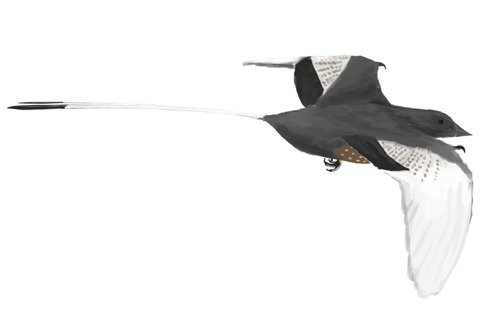Feathered dinosaurs might not still be the new boys in town in the fossil world, but there’s still a tonne of cool research being done on them. One of the main fields is trying to figure out if different species were capable of powered flight, like in most modern birds. The recent finding of Aurornis xui appears to have confined the ability to fly just to a single feathered lineage, the one leading to modern birds, but how do we figure out whether they could fly or not?

Reconstruction of Aurornis xui. Credit: Masato Hattori (source)
Flight is a pretty complex function, and you need to have the right bone structure, muscles, and feathers (or the webbing like in bats and pterosaurs), as well as the right combination of these to generate an aerodynamic effect. Various studies have attempted to compare these aspects in modern birds and their ancient dinosaur ancestors.
One of these compared the length of primary feathers, the long ones that take up about half the wing length in modern birds, to arm length in modern and extinct feathered theropod dinosaurs. They found that dinosaurs like Confucuisornis may have been limited to gliding based on these proportions, and that a group of cool extinct birds called Enantiornithes were experimentalists, and tried a whole range of flight styles, including some of those in modern birds.

Confuciusornis sanctus reconstruction. Illustration by Matt Martyniuk (source)
A new study has now cast new light into this realm, by seeing how much we can really tell from primary feather lengths. The reason why these feathers are so important is that they are the main source for generating thrust, with insane complexity for reducing drag and being mechanically efficient.
Modern birds have many different and broadly defined flight styles: divers, fast flappers, manoeuvring flappers, slow flappers with rapid take off, and soaring. As these are known categories, it’s possible to compare features such as forelimb length or length of primary feathers in extinct species to see which categories they’d fall in to.
Using a pretty hefty dataset of extinct and extant species (50 former, 34 latter), the team broke down their measurement data using a technique called principal components analysis (PCA). This is a widely used statistical method that reduces the complexity of datasets with many variables into smaller variables (principal components) that still explain a substantial amount of variation within the data. You can then plot these on a graph, and if you have different categories then you can see where the members of the different groups fall out next to each other. It’s a pretty cool way of comparing what we call ‘morphospace’, or the variation between species or specimens in terms of aspects of their anatomy.
One problem with analyses of this sort is the concept of phylogeny. Phylogeny describes the way in which organisms are related in the grand tree of life, and it’s expected that organisms that are phylogenetically closer to each other will be more morphologically similar than those further apart. As such, results you get from things like PCA may not represent anything functional, but may be more to do with the way in which organisms are related. Fortunately, software exists that you can use to ‘subtract’ the amount of variance in the data set that is to do with phylogeny, as long as you have a tree that represents all the animals studied.

Phylogeny of the species analysed in the study (source)
When this is accounted for, along with other variables such as overall wing size, there is almost no clear separation between the different functional groups in extant birds. This result might be surprising, but PCA isn’t actually designed for this kind of group separation analysis, merely for reducing the dimensionality of a data set to be more manageable, and then show this graphically. To look for functional group differences, an extension such as a canonical variates analysis (CVA) could have been performed, which is a method that attempts to pull groups apart by maximising the distance in space between the group means, or centroids.
Regardless, the PCA shows that modern birds are more conservative in their limb element lengths, as they appear to have unlocked the winning combination that leads to flight capability. On the other hand, Mesozoic birds and feathered dinosaurs experimented quite a bit. Some early groups, for example, reduced their primary feather lengths decreasing the ratio of forelimb length to primary feather length, and rendering them incapable of flight. Enantiornithes, on the other hand, show a strong convergence with modern birds in terms of their size and limb bone proportions, suggesting too that they were capable of powered flight.

Maybe some dinosaurs were pretty awesome at experimenting? (source)
Unfortunately though, the different flying modes mentioned earlier were not distinguishable, so flight mode may be decoupled from feather length and limb length, and can’t be used to predict flight styles in extinct feathered beasties. It would be interesting to see if this result holds up if more appropriate modes of analysis are conducted though!
Like much other evidence, this neat li’l study goes to show that feathers weren’t initially designed for flight, and likely for other aspects of life such as keeping warm, brooding, or display. Alternatively, there could be modes of flight which dinosaurs converged upon, and which we just can’t detect by comparing them to modern birds!

OK, so some dinosaurs just weren’t cut out for flying.. (source)
References: Chan, N. R., Dyke, G. J. and Benton, M. J. (2013) Primary feather lengths may not be important for inferring the flight styles of Mesozoic birds, Lethaia, 46, 146-152 (link)

Pingback: Fossil feathers are frickin’ sweet | Green Tea and Velociraptors
Pingback: Dinosaurs of a feather? | Fashion